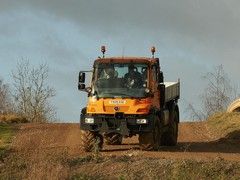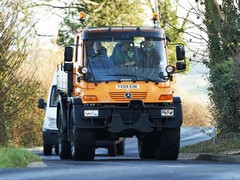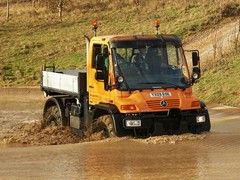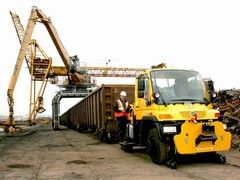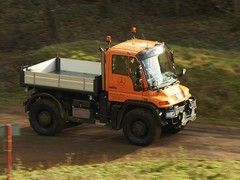Driven: Mercedes Unimog
Cool name, cool looks, cool tech ... the Unimog is just, well, cool
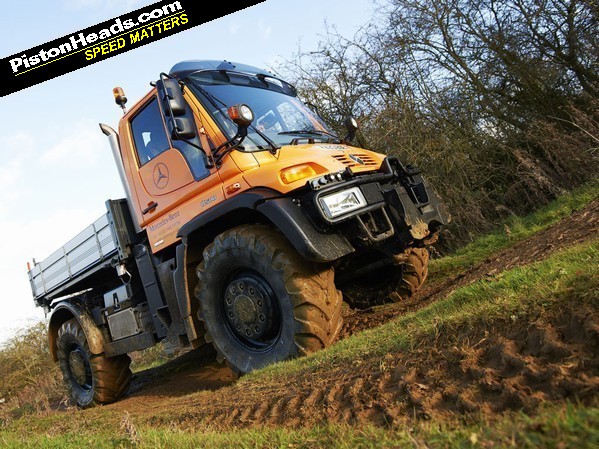
And some of us don't grow out of it. Chances are if you've ever seen a Unimog in the metal you'll have reverted back to that three-year-old self, pointing and cooing and full of innocent wonder.
Why on earth should a decidedly unglamorous vehicle like a Unimog do this though? Sure, you can understand it with a supercar. But Unimogs aren't fast. They do deeply unexciting jobs like clean tunnels and road signs. But in that curious German way Mercedes has managed to take an efficiently Teutonic and matter of fact description - Universal-Motor-Gerat - and condense it into something that instantly sounds cool. Translated it means universal motorised tool and, yup, that's pretty much what the Unimog is.
But appliances aren't meant to be cool. They're meant to be ... appliances.
I want one of those
In the metal the Unimog's proportions are so outlandish as to be almost cartoonish. Monster-truck worthy tyres mean it towers above everything while the cab, slatted, functional and yet styled with references to Unimogs of old looks like nothing else. From every surface sprout massively overbuilt mountings, sockets and, well, stuff. It's like every Tonka toy you ever had, oversized and made real.
It's a fair climb up into the cab, the steps barely circumnavigating an enormous tyre already dripping in mud. The view from the cab is incredible, the windscreen curving down to seemingly your ankles and the deep side windows meaning you have fantastic visibility. Indeed, given the height off the ground you could almost be in one of those old-school Bell helicopters with the goldfish bowl cockpits.
The controls are bewilderingly complex too. Unimogs are endlessly customisable and some permit conversion from right- to left-hand drive and vice versa by sliding the whole steering wheel, console and pedal box across to the relevant side of the cab in less than a minute.
Complex beast
The basic controls are straightforward enough, there being a big truck wheel, three pedals and a sequential gear selector shaped like an aircraft throttle. But there's also a fearsomely complex panel controlling the off-road hardware and another for the load bed and - where fitted - various hydraulic implements that can be hung from it both front and rear.
And here's the clever stuff. Unimogs have long been used by German local authorities for all sorts of duties but the price - our test vehicle would cost around £130,000 - has been a barrier to wider acceptance here beyond a few specialist operators. Tree surgeons and utilities companies are among existing fans, the latter using the Unimog's go-anywhere ability for fixing remote power lines and suchlike. Here the ability to deflate the tyres from the dash means soft ground and moorland can be covered without carving up delicate habitats. It might look fearsome but the 'mog can tread lightly when needed.
Broad repertoire
Councils - Wiltshire among them - are coming round to the Unimog's potential though. Come winter they can grit and plough snow but there's year-round use for them too, from verge clearing to sign cleaning. In the latter role alone a Unimog with a mechanised washing arm can clean four times as many signs in a day as a crew of guys can manually.
Gatwick airport has a fleet of them for clearing snow off runways and specially adapted Unimogs are also employed to clean the walls and roofs of the Rotherhithe, Blackwall and Dartford tunnels. And with a torque convertor transmission a Unimog can even shunt trains of up to 900 tonnes.
With tyres like that it seems a shame not to go mud plugging though, Mercedes inviting us to the off-road test area at the Millbrook proving ground in Bedfordshire.
The short wheelbase and zero overhangs have always been a Unimog trademark, likewise the portal axle design that hoicks the diffe
rential above the centre line of the hubs and dramatically increases ground clearance. As used on military vehicles like the VW Beetle-based Kubelwagen and original Humvee, the portal axle has become a signature Unimog feature, likewise the coil-sprung suspension (unusual back in the early 50s) and power take-offs (PTOs) mounted at the front, middle and rear of the vehicle.60-year tradition
The U300/400/500 range launched in 2000, the huge windscreen and curved bonnet harking back to the original of 1951. And though the 60 intervening years have seen a huge amount of development today's Unimog is remarkably honest to the original concept.
For all that complexity it's very easy to drive too. As standard there are eight forward gears and six or eight reverse. Transfer boxes can multiply that by two or three according to needs, making a total of 24 forward gears if you reckon you require them.
Thankfully a selector switch with, respectively, a hare, a packhorse or a tortoise for standard, low range and crawler gears helps slim the choice down and to get going you simply dip the clutch, knock the selector and it'll pick the appropriate ratio. The clutch is sharp and the 'mog gets going with a lurch and you quickly start rattling through the gear changes. Each is greeted with a hiss of pneumatics, a clank of heavy duty components from somewhere beneath you and renewed forward progress all the way up to a top speed of 56mph.
The main controls for off road driving are the two-stage exhaust brake, controlled via a column stalk, and the rotary dial operating the differential locks. With that enormous field of view steep downhill slopes are somewhat alarming, the exhaust brake holding the Unimog at a crawl no matter how unlikely the gradient. And on the way back up you work your way through the gears with a succession of psssst-clack shifts and then a sense of unstoppable progress as the giant tyres claw their way through sand, gravel and mud with utter disdain.
It's barely a taste of what the Unimog can actually do but if the sight of one of these things is enough to prompt childish giggles that's nothing compared with the chance to actually drive one. And while there's no possible reason for running a 'mog as a civilian vehicle there are ways in which the Unimog itchcan be scratched more manageably. Of which more in due course...
Mercedes-Benz Unimog U500
Engine: 6,370cc 6-cyl turbocharged
Power (hp): 286@2,200rpm
Torque (lb ft): 826
0-62mph: N/A
Top speed: 56mph
Weight: 7,500kg
MPG: N/A
CO2: N/A
Price: c. £100,000 depending on specification
Gassing Station | General Gassing | Top of Page | What's New | My Stuff

